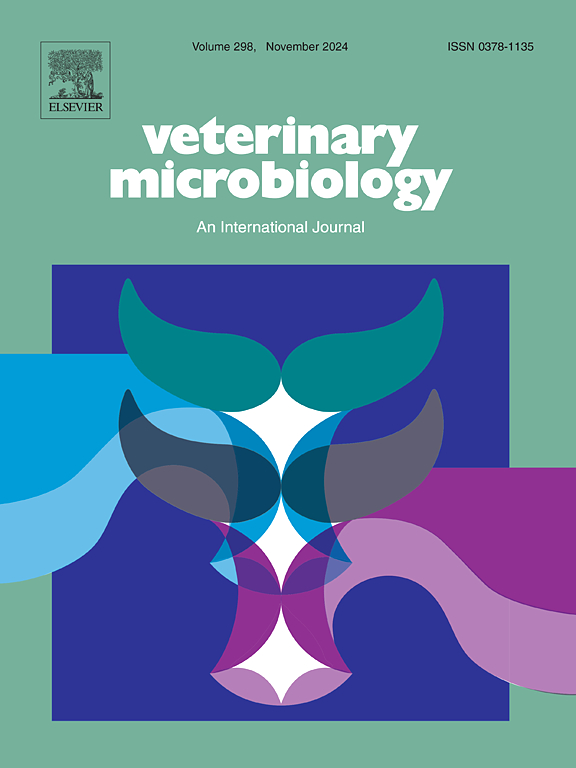Contamination of alpine pastures by Mycobacterium avium subsp. paratuberculosis: Evaluation of cattle and red deer contribution through environmental fecal samples
IF 2.7
2区 农林科学
Q3 MICROBIOLOGY
引用次数: 0
Abstract
Paratuberculosis is a chronic enteritis of ruminants (Bovidae, Cervidae) caused by Mycobacterium avium subsp. paratuberculosis (MAP). The prevalence of shedding animals, together with fecal MAP loads, is critical to the biocontamination of the environment. Surveillance for paratuberculosis has been introduced within the frame of European Health Law (Regulation EU 2016/429) both in livestock and wild ruminants. Semi-extensive and extensive livestock production may determine exposure to MAP infection and intraspecies and interspecies transmission on pasture. In the present study MAP prevalence and viable shedding in red deer and cattle were assessed through environmental fecal sampling over two summer seasons in the Alps. A low but widespread percentage of MAP-positive feces in both species was observed, indicating a small proportion of MAP grazing shedders. Consequently, the risk for MAP exposure on alpine pastures seems to be low. The highest contamination was reported mainly in overlapping areas for both species. The present study supports the utility and reliability of environmental fecal sampling as a non-invasive sampling approach to assess paratuberculosis shedding in grazing animals.
禽分枝杆菌亚种对高山牧场的污染。副结核:通过环境粪便样本评估牛和马鹿的贡献
副结核是一种由鸟分枝杆菌亚种引起的反刍动物(牛科、鹿科)慢性肠炎。副结核(地图)。动物脱毛的流行以及粪便中的MAP负荷对环境的生物污染至关重要。在欧洲卫生法(欧盟第2016/429号条例)框架内,在牲畜和野生反刍动物中引入了副结核病监测。半粗放型和粗放型畜牧生产可能决定牧场上MAP感染的暴露程度以及种内和种间传播。在本研究中,通过对阿尔卑斯山两个夏季的环境粪便取样,评估了马鹿和牛的MAP患病率和活菌脱落。在这两个物种中,MAP阳性粪便的比例都很低,但很普遍,这表明MAP放牧放牧者的比例很小。因此,高山牧场暴露于MAP的风险似乎很低。污染最严重的地区主要是两种物种的重叠区。本研究支持环境粪便采样作为一种非侵入性采样方法来评估放牧动物的副结核脱落的实用性和可靠性。
本文章由计算机程序翻译,如有差异,请以英文原文为准。
求助全文
约1分钟内获得全文
求助全文
来源期刊

Veterinary microbiology
农林科学-兽医学
CiteScore
5.90
自引率
6.10%
发文量
221
审稿时长
52 days
期刊介绍:
Veterinary Microbiology is concerned with microbial (bacterial, fungal, viral) diseases of domesticated vertebrate animals (livestock, companion animals, fur-bearing animals, game, poultry, fish) that supply food, other useful products or companionship. In addition, Microbial diseases of wild animals living in captivity, or as members of the feral fauna will also be considered if the infections are of interest because of their interrelation with humans (zoonoses) and/or domestic animals. Studies of antimicrobial resistance are also included, provided that the results represent a substantial advance in knowledge. Authors are strongly encouraged to read - prior to submission - the Editorials (''Scope or cope'' and ''Scope or cope II'') published previously in the journal. The Editors reserve the right to suggest submission to another journal for those papers which they feel would be more appropriate for consideration by that journal.
Original research papers of high quality and novelty on aspects of control, host response, molecular biology, pathogenesis, prevention, and treatment of microbial diseases of animals are published. Papers dealing primarily with immunology, epidemiology, molecular biology and antiviral or microbial agents will only be considered if they demonstrate a clear impact on a disease. Papers focusing solely on diagnostic techniques (such as another PCR protocol or ELISA) will not be published - focus should be on a microorganism and not on a particular technique. Papers only reporting microbial sequences, transcriptomics data, or proteomics data will not be considered unless the results represent a substantial advance in knowledge.
Drug trial papers will be considered if they have general application or significance. Papers on the identification of microorganisms will also be considered, but detailed taxonomic studies do not fall within the scope of the journal. Case reports will not be published, unless they have general application or contain novel aspects. Papers of geographically limited interest, which repeat what had been established elsewhere will not be considered. The readership of the journal is global.
 求助内容:
求助内容: 应助结果提醒方式:
应助结果提醒方式:


